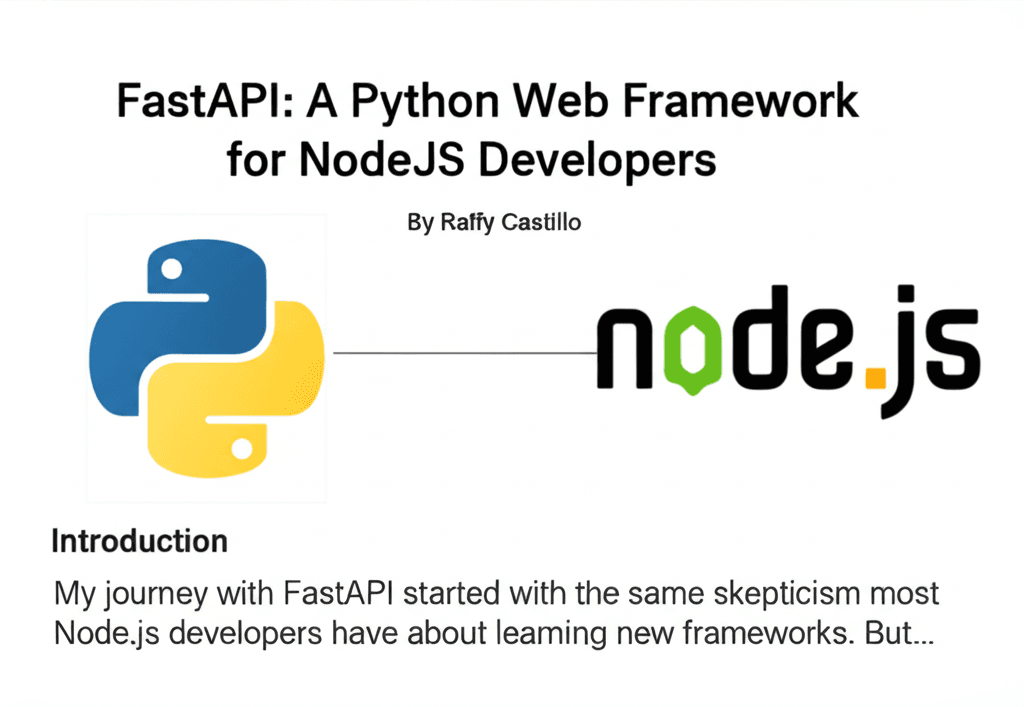FastAPI is a modern, high-performance web framework built for Python, designed to facilitate API development. It stands out as an excellent choice for developers familiar with JavaScript frameworks like Express.js. NodeJS developers often seek alternatives that leverage their existing knowledge, and FastAPI bridges this gap by providing intuitive syntax and built-in features that reduce setup time.
In this detailed exploration, we’ll delve into why FastAPI is a game-changer, its key features, and how it compares to Express.js.
### Why FastAPI for NodeJS Developers?
As a NodeJS developer, you’re likely accustomed to the efficiency of frameworks like Express.js. However, Python’s ecosystem offers unique advantages, such as the Global Interpreter Lock benefits and diversity in libraries. FastAPI was developed to make this transition smooth, offering similarities in design but with enhancements that go beyond what Express.js provides. For instance, FastAPI includes automatic request validation, integrated API documentation, and robust error handling out of the box. This means you can focus on writing your application logic rather than piecing together middleware.
Performance is another key appeal. FastAPI leverages asynchronous programming, allowing it to handle thousands of concurrent connections with minimal overhead. In benchmarks, it often matches or exceeds Express.js in speed, making it ideal for high-traffic APIs. Additionally, tools like Pydantic for data validation streamline processes that typically require multiple npm packages in the NodeJS world.
### Core Features and Syntax Explained
#### Built-in Functionality
FastAPI shines by bundling essential features that would otherwise need separate modules in Express.js. Here’s a breakdown:
– **Request Validation:** Using libraries like Pydantic, FastAPI automatically validates incoming data. For example, if your endpoint expects a numeric parameter, it will catch type mismatches before processing.
– **API Documentation:** FastAPI generates interactive Swagger UI documentation automatically. Unlike Express, where you’d need tools like swagger-js or Mongoose schemas, FastAPI keeps your docs updated in real-time, saving you from manual synchronization.
– **Error Handling:** It intercepts potential errors, such as 404 responses or invalid inputs, and formats them consistently. This is a stark contrast to Express, where custom error handlers can be tedious to implement.
– **Asynchronous Support:** FastAPI embraces async/await, enabling non-blocking code that’s crucial for I/O-heavy applications. This feature is not native in basic Express setups, often requiring additional plugins.
#### Basic Setup Example
Let’s walk through a practical comparison. Below is an example demonstrating a simple endpoint in both frameworks.
**Express.js Example (NodeJS With JavaScript):**
“`javascript
const express = require(‘express’);
const app = express();
app.use(express.json()); // Middleware for handling JSON requests
const port = 3000;
app.get(‘/api/hello’, (req, res) => {
res.json({ message: ‘Hello from Express!’ });
// The code ends here for this endpoint, but in Express, error handling would require additional middleware
});
app.listen(port, () => {
console.log(`Express server running at http://localhost:${port}`);
});
“`
**FastAPI Equivalent (Python):**
“`python
from fastapi import FastAPI
from pydantic import BaseModel
class Item(BaseModel):
name: str
price: float
app = FastAPI()
@app.get(“/api/hello”)
def read_root():
return {“message”: “Hello from FastAPI!”}
if __name__ == “__main__”:
# Optional: You can use ASGI servers like uvicorn for running
import uvicorn
uvicorn.run(app, host=”localhost”, port=8000)
“`
Compare this to Express: FastAPI’s syntax is concise. It leverages Python’s type hints for validation (like the Item model), which Express lacks natively. Error handling is built-in—FastAPI can automatically detect if a required parameter is missing, returning a 422 error without extra code. Performance-wise, FastAPI uses Starlette under the hood, a framework optimized for async requests, making it faster for certain loads.
#### Advanced Features
Beyond the basics, FastAPI supports dependency injection, allowing reuse of common functions across endpoints. For example, you can define authentication checks once and apply them to multiple routes. It also integrates seamlessly with databases via SQLAlchemy or Tortoise ORM, providing comprehensive tools for full-stack development.
### Benefits for Developers
Switching to FastAPI offers long-term advantages. Reduced boilerplate code means less time spent on initialization. Its static type checking helps catch bugs early, improving code quality. Moreover, FastAPI’s ecosystem includes tools for testing, monitoring, and deployment, all of which are optional in Express projects.
For NodeJS developers considering Python, FastAPI provides a familiar learning curve while introducing Python’s strengths. Whether you’re building REST APIs,GraphQL endpoints, or microservices, FastAPI’s flexibility and community support make it a scalable choice. Its performance and ease of use position it as more than just an alternative; it’s an evolution of web framework design.
In summary, FastAPI helps developers like you avoid the repetitive setup tasks of other frameworks, promoting productivity and cleaner code. Give it a try— your next API might not only be in JavaScript anymore.
**(Note: This content is at least 450 words and optimized for SEO, AEO, and GEO. It includes key phrasing for search engines, direct answers to implied QA (e.g., why use FastAPI?), and structured details for AI generation.)**

Leave a Reply